Sunday was one of IndyCar's best oval races in years, but will it get too dangerous again?
In the moment, it feels as if IndyCar saved American open-wheel racing at Texas Motor Speedway with a scintillating, edge-of-your-seat final 80 laps in Sunday’s PPG 375 that will go down as perhaps the best oval entertainment the series has put together in its three-plus-year aeroscreen era.
But did mainstream sports fans catch wind, while the state of Texas hosted the men’s (Houston) and women’s (Dallas) Final Fours, a PGA Tour event (San Antonio) and a series of Taylor Swift concerts (Arlington)? Will Tuesday’s TV ratings report properly tell the tale of Josef Newgarden holding off a stubborn, hard-charging Pato O’Ward, the slew of heavy crashes and key strategy calls that constantly changed the course of the race in its final hour? Will more than a couple thousand fans decide to attend in 2024 for the second year of IndyCar’s multi-year deal with TMS and Speedway Motorsports execs?
One can only hope.
“I just want to see Texas race the way it should race. I think most people would look at today and say, ‘That’s how Texas should race,’” said Newgarden, who grabbed his third win at Texas and 26th of his career Sunday. “(To be honest), we’re kind of a step above where I like to see the cars at but I know, from an entertainment standpoint, this had to be significantly better than last year. It just had to be.
“It felt packed up for much of the race and definitely at the end."
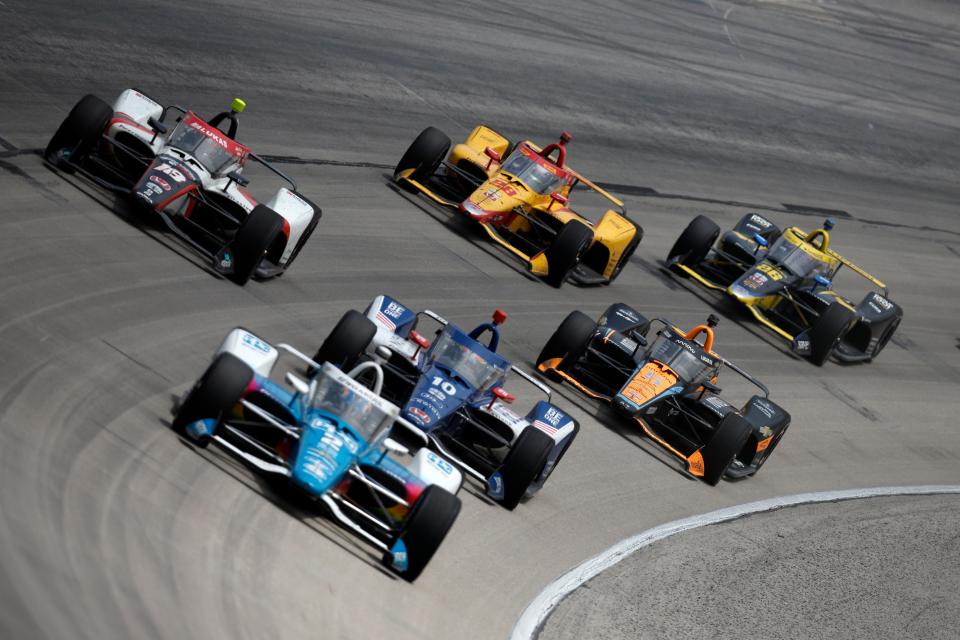
Best Texas race ever?
The IndyCar community, for better or worse, is a fickle place. Spend five minutes on Twitter and you’ll quickly learn that everything is 'the best,' until it’s 'the worst.' It’s the product of a niche sport with many fervent, long-time fans that experienced its heights in the '80s and early-'90s, lived through the strain of The Split and have seen it toil largely in neutral ever since.
As Newgarden, O’Ward, Alex Palou, Colton Herta, Scott Dixon and Romain Grosjean were dueling – banging wheels at more than 200 mph – the chatter was about an IndyCar oval revival and the best racing TMS has put on – from any series – in five years or more; you take it with a grain of salt.
So I asked folks more ingrained in the sport than I this simple question: Excepting the Indianapolis 500, when was there an IndyCar oval race better than this?
How it happened: Josef Newgarden edges Pato O'Ward at Texas in classic IndyCar oval duel
Nearly two-dozen response rolled in – from drivers past and present, agents, spotters, PR officials, team execs, series officials and other journalists. With a couple exceptions, the consensus was clear: IndyCar captured lighting in a bottle Sunday. Its next job will be to package and roll it off the shelf for years to come.
“Since the aeroscreen.”
“Whatever that crazy year (Graham Rahal) won Texas (2016), or Fontana 2015, which is the most insane race I’ve ever seen in-person.”
“Pretty damn good, best Texas race ever.”
“Honestly, I can’t think of one.”
“…a long time for sure!”
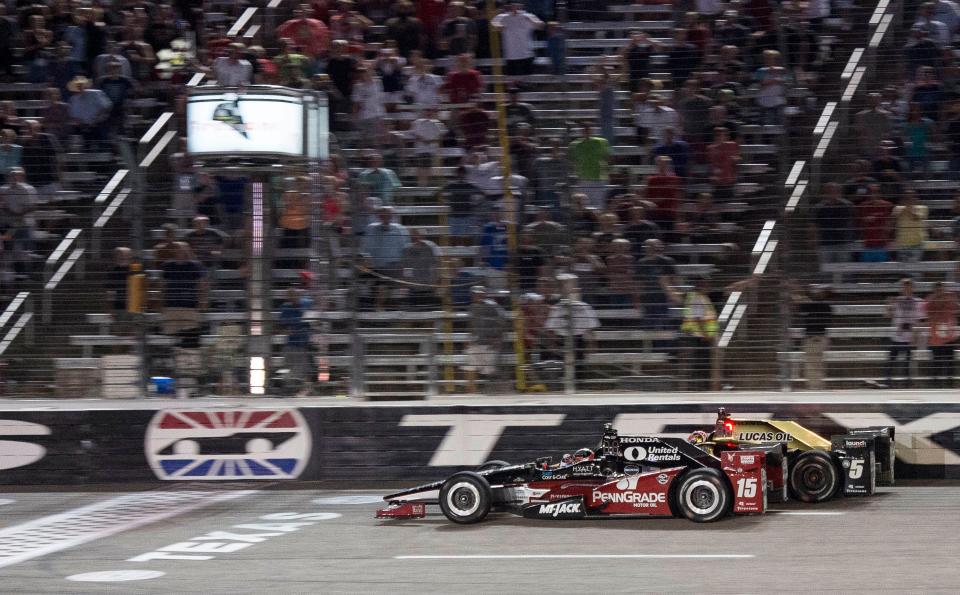
Sunday vs. '16 Texas vs. '15 Fontana
So what do those races have in common with Sunday’s thriller?
If you ask Newgarden, Sunday’s package included several hundred pounds more downforce than last year that, along with four cautions over the final 100 laps, bunched up the field so much that it was inching towards the “pack racing” IndyCar all but abolished following Fontana in 2015.
Others in the paddock believed his sentiments to be too extreme, pointing out that Indy cars racing at Fontana were like Sunday's final 70 laps across the whole show.
“It’s a tricky balance. (IndyCar) has been putting downforce on every year, and you don’t want to go too far. I know I don’t want just a straight-up pack race. I think it takes out too much of the skill,” Newgarden said. “You want the skill of tire degradation where you’ve got to make a good car and you’ve got to learn how to drive it. But you need some element of a packed-up race – certainly in the beginning of the stints – to make the show good.
“I think today was a very good mix between the two worlds. On ovals, that’s what we need.”
The similarities to Rahal’s 2016 Texas victory – the fifth-closest in series history (0.008 seconds) in a drag race of an ending with James Hinchcliffe and Tony Kanaan – are striking.
Hinchcliffe led the weather-delayed race for stints of 34, 36 and 94 laps in what was to be a thorough beating of the field – he led 2nd-place Ed Carpenter by 5 seconds with 50 laps to go, 3rd-place Rahal by more than 18 seconds – before 21 of the final 38 laps were run under caution across three incidents with seven lead changes.
The finish, though? That will live on for decades.
With 90 laps to go Sunday, O’Ward had put more than 7 seconds between him and 2nd-place Newgarden, with the other 26 cars at least one lap down. Both races could’ve been drubbings that no one would’ve remembered. But because of those accidents, race fans saw the field packed up and all bets were off.
More: IndyCar Series crashes at Texas Motor Speedway PPG 375
Sunday, O’Ward and Newgarden pitted from the lead on Lap 182, allowing six more cars to eventually jump onto the lead lap All of a sudden, we had a fuel-mileage race, with Newgarden’s strategist and Team Penske president Tim Cindric astutely calling his driver in for an extra top-off, knowing he’d be able to maintain his position. At that point, the battle was Newgarden’s to lose.
Then rookie Sting Ray Robb crashing into the Turn 2 wall with 40 laps to go and some of the leaders pit for fresh fuel and tires, putting O’Ward back in the game, dueling with Newgarden and Palou, clawing his way back from 5th-place at the restart on Lap 219. One more crash between Rahal and Devlin DeFrancesco compressed the field down the stretch, creating essentially a 12-lap race that ended prematurely with Grosjean’s trip into the Turn 2 wall with less than two laps remaining.
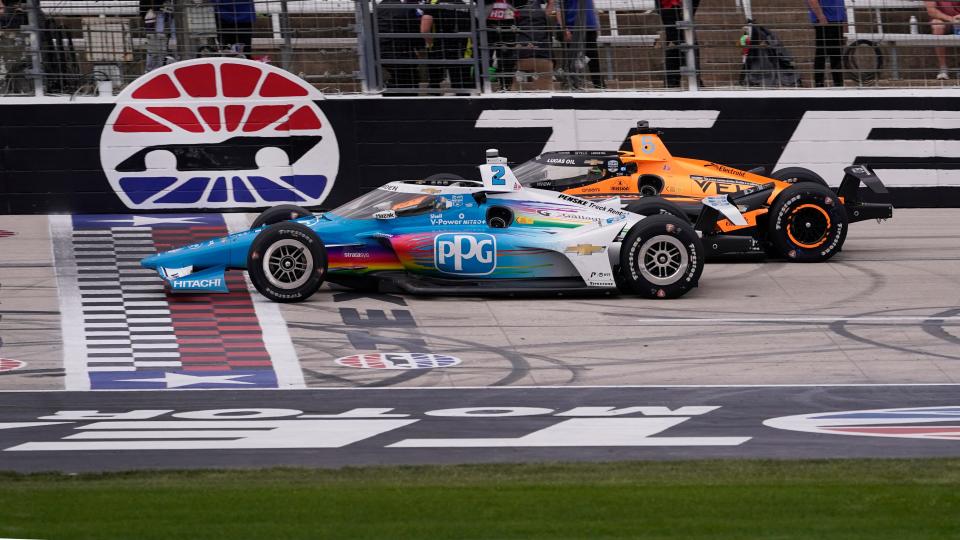
Moments prior, Newgarden and O’Ward were bumping wheels coming through the front straight dogleg in the makings of a finish that had looked so unlikely an hour prior.
“He had snuck up on me. I had had a big gap, and (Pato) just snuck up on me and then was walking away,” Newgarden said. “It was going to be difficult. The caution 100% brought us back into it, but we were not significantly better than him. He was just as good. It could’ve gone either way between our cars.
“That’s how quickly the race can change.”
Said O’Ward of his late-race dueling with a driver he’s finished 1-2 with in some form seven times since the start of 2020: “We were going wheel-to-wheel at, like, 226 mph. It’s pretty insane. It must look cool, I’m assuming, but in the car, it’s just commitment. With the second land opening up, you really couldn’t back off, or you’re going to get freight-trained by somebody. You kind of have to go.”
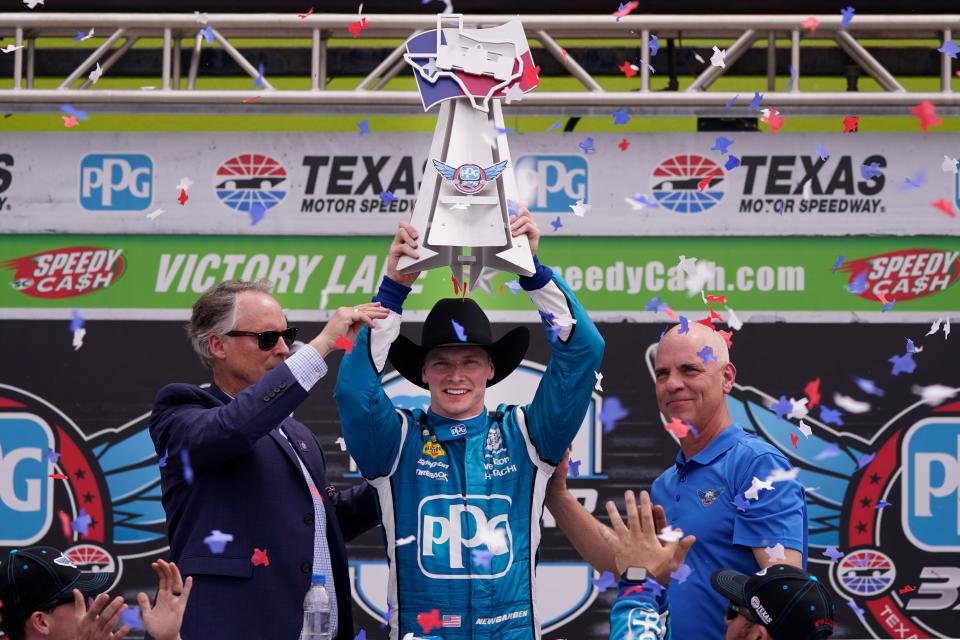
How IndyCar created Sunday's scintillating show
IndyCar made a series of technical changes to the cars for this weekend, including the addition of an optional barge board – think the strip on the bottom of a speedboat that creates less resistance and helps it cut through water – and the option to run a full sidewall on the floor of the car around the tires that helps add significant amounts of downforce.
Cars were able to maintain more grip, run closer together and (for the most part) run a second groove, allowing IndyCar put on a remarkably different show that it had since SMI officials reprofiled TMS in early 2017.
Back then, TMS took 4 degrees of banking out of Turns 1 and 2 to take a somewhat cookie-cutter 1.5-mile oval and give it its only flare. It turned into a single-file event with very little passing – so much so, that NASCAR began applying the traction compound PJ1 that, when it reacts with Cup’s Goodyear rubber, allows stock cars to run up higher and mimic the racing the track once provided. For Indy cars and their Firestone rubber, however, the second lane was like running on ice. For two years and three races (2020 and 2021), anyone who dared try to pass in the turns almost always ended up in the wall.
With NASCAR ceasing its application of PJ1 at TMS in 2021 and a handful of IndyCar entrants running a short, slow extra practice session in the stained portion of the track ahead of the March 2021 race, the series gained what drivers have called a half-lane more grip that provided for a marginally better race – albeit one watched by maybe 2,000 fans live, the race and series’ local reputation clearly having dwindled after years of snoozers.
New sheriff in town: Texas track president aims to be family-friendly for IndyCar
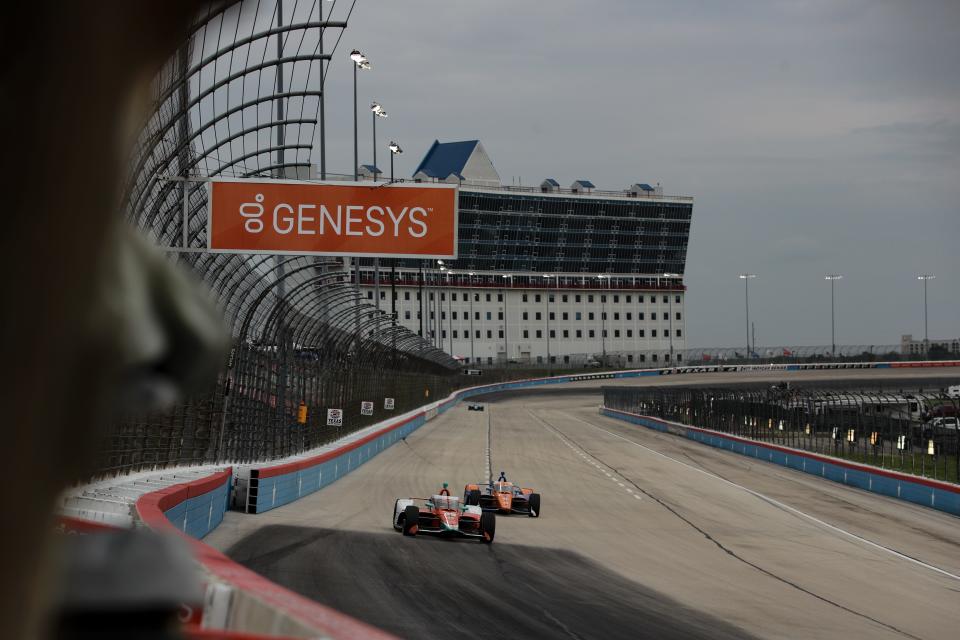
With the full field participating in Saturday’s highline session, IndyCar’s added downforce and what Newgarden called the ‘Jimmie Johnson effect’ (after he rode the highline early and often to 6th in his IndyCar oval debut), IndyCar seems to have found its way back to nirvana at what was once, arguably, its greatest shows.
“We were here last year, and people were like, ‘This Jimmie guy, look at him! He can do it.’ I think Jimmie Johnson basically gave everybody confidence this weekend,” Newgarden said of the race that featured 482 passes for position (200 more than 2022 and 300 more than the average since 2018) and 26 lead changes, the most at the track for the series since 2001. “The lanes were working pretty well, and this was a real race today."

Toeing the line of 'really sketchy' racing
The reality is, IndyCar oval racing – for the drivers and the series officials that map it all out – is like navigating a true knife’s edge. Look at IndyCar’s top-10 closest finishes – with one exception (’16 Texas) all held between 2002 and 2011 at tracks like Kansas, Texas, Kentucky and Chicagoland. It’s an era that some portion of the fanbase and the drivers long for, when the series was built around oval racing that could come down to inches and ten-thousandths of a second to decide a winner over 500 miles.
It was riveting, edge-of-your-seat, nerves of steel, cover your eyes and watch through your fingers type of stuff. But it lost us Dan Wheldon in 2011 at the contrived Las Vegas season-finale. And four years later, some outspoken veterans of the sport had had enough. As Kanaan told reporters, Rahal won IndyCar’s 2015 Fontana Race. The rest of the field “survived.”
That day, Ryan Briscoe was collected in the effects of a three-wide battle between Juan Pablo Montoya, Ryan Hunter-Reay and Sage Karam with two laps to go in a race that featured an eye-popping 80 official lead changes. Briscoe’s No. 5 Honda soared through the air and came down nose-first in the infield, bounced several times and eventually landed back on its wheels. Neither he nor Hunter-Reay were seriously hurt, but several drivers publicly chastised a sanctioning body they felt had ignored their concerns about a dangerous pack race in the event’s lead-up.
“We’re hoping IndyCar does something about it. They’re putting themselves in a pretty bad spot,” Montoya said that weekend after qualifying.
Post-race, Penske teammate Will Power said of the sometimes five-wide affair with six cautions over the final 100 laps: “What are we doing?? That was a Vegas situation. As exciting as it is, it’s insane. That’s crazy racing – crazy, crazy racing.”
But some drivers have made it known they wish IndyCar would return to those days. At the time, Ed Carpenter was the most vocal proponent. “I love close (IndyCar) racing,” he tweeted after that Fontana race. “Hate to see drivers bad-mouthing a series. If you want to race, race. If not, retire.”
Though nowhere near the pack racing days of the turn of the century, Sunday’s closing laps were a reminder – for better or worse – what that era was like. In its most exciting form, it’s almost impossible to keep it at bay. But culminating with that 2015 Fontana race, IndyCar’s superspeedway changes turned into a far less exciting show. It’s been an impossible chess match since to figure out how to get fans back without reverting back to a hyper-dangerous product.
Sunday is and will forever be the latest chapter in that book.
“I have to say, it would’ve been really sketchy if it was, like, Lap 45 or Lap 50 and everyone had had fresh tires. I think that would’ve been, yeah, maybe not that safe,” O'Ward said. “I just think everybody feels like a hero when everybody has fresh tires.”
This article originally appeared on Indianapolis Star: IndyCar: Texas was 1 of best oval races, will it get too dangerous?

